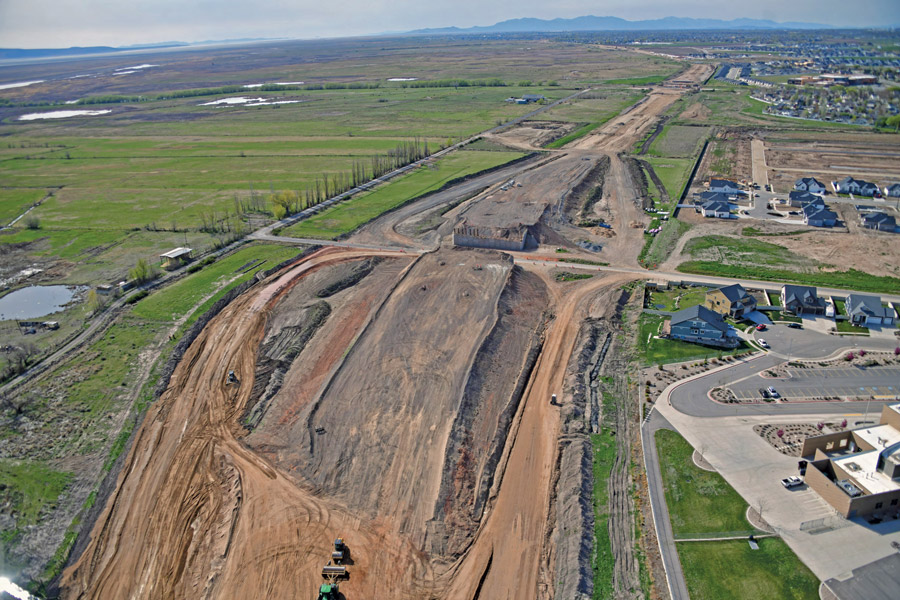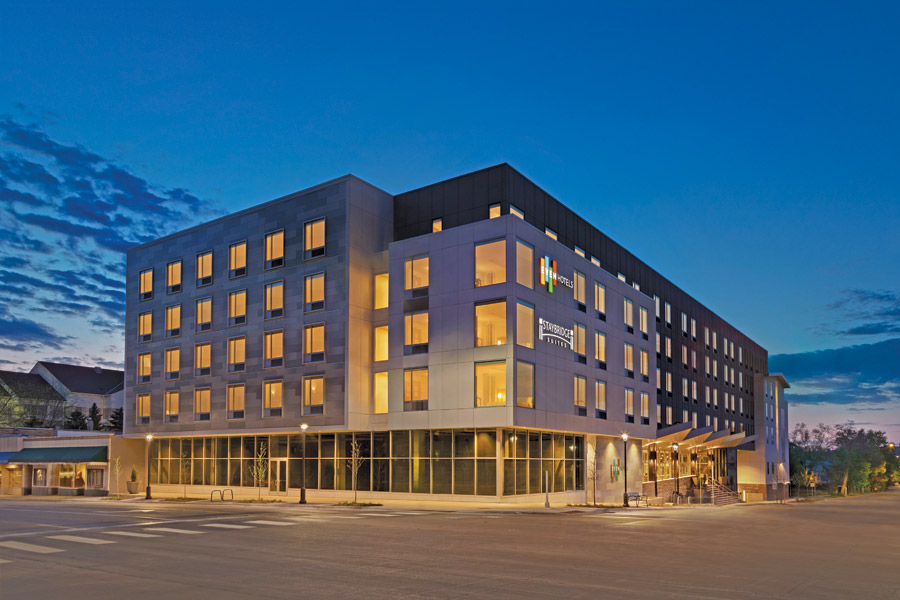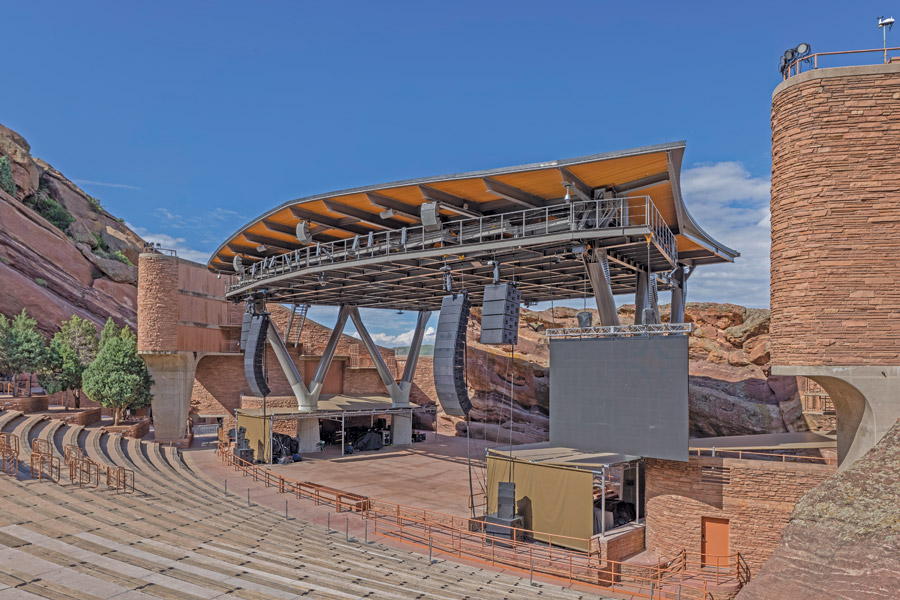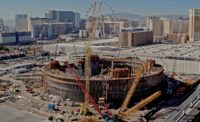Top Design Firms Overview
Transportation Work Keeping Regional Designers Busy

Reconstruction of a runway at Jackson Hole Airport began in the spring of 2022.
Image courtesy of Jviation, a Woolpert Co.
Transit, aviation, industrial and manufacturing; single- and multifamily housing; and efforts to help alleviate climate change are among the expected growth areas for design firms in the Mountain States. Meanwhile, the firms themselves are experiencing rapid changes, including adjustments to remote and hybrid work, ongoing staff shortages and a wave of mergers and acquisitions.
In 2020, architecture, engineering and geospatial firm Woolpert acquired Jviation Inc., an aviation-centric firm based in Denver. The acquisition allowed Woolpert to expand its nationwide footprint and contributed to an increase in regional revenue for 2021, says JD Ingram, aviation market director in the company’s Denver office. Woolpert reported $21.2 million in regional revenue last year.
“Our aviation market in the region has experienced the most improvement with the resurgence of passenger air traffic in recent months. And, with the passing of the federal infrastructure act, we anticipate the aviation market will continue to improve as well as the [broader] transportation market,” he says.
Two Woolpert regional projects under construction are the $45-million Runway 1/19 Reconstruction at Jackson Hole Airport in Wyoming and the $42.4-million Taxiway Echo/Echo design at Denver International Airport.
At Jackson Hole, the company designed a surface capture runoff system with redundant slot drains on each side of the runway that will collect and send runoff flows to the airport’s recently constructed underground detention and filtration system, Ingram says.
In addition, the team recycled most of the existing pavement. It will be reused in the new pavement section through a reclamation and stabilization process that recycles 85,000 cu yd of aggregate base and asphalt materials that otherwise would need to be imported. Also, workers screened and crushed new base course aggregate from onsite sources, which further reduced the import of materials.

DIA’s Concourse A West Expansion incorporates an exterior skin of glass and metal panels to emulate the Rocky Mountains. HNTB designed the outdoor deck so passengers can take advantage of views to the west while enjoying a cocktail from the bar.
Photo courtesy of HNTB
In Denver, to align with FAA funding, the complex design required an expedited schedule, Ingram says. The project includes taxiway lighting and signage, circuit installation, Navaid relocation, underdrain and storm sewer work and full-depth pavement construction. In addition, to meet FAA criteria, the team had to perform extensive earthwork to achieve the required taxiway centerline gradient, he says.
Infrastructure specialist HNTB reported $69.9 million in regional revenue for 2021. The company’s Salt Lake City office leader, Dominic Spaethling, largely attributes this to the company’s design role with Ames Construction on the Utah Dept. of Transportation’s West Davis Corridor Design-Build.
The $800-million project will create a 16-mile, four-lane divided highway on an ancient lake bed stretching from I-15 in Centerville City to SR-193 in West Point City. The project includes six interchanges, associated cross-street connections and grade separations and 10 miles of new trails and trail connections.

The 16-mile West Davis Corridor project progresses between the I-15 interchange and the city of Syracuse, Utah.
Photo courtesy Farmington Bay Constructors
At DIA, HNTB continues work on the $560-million Concourse A West Expansion Program, scheduled for completion in late 2022. The program will add gates at the end of each concourse and provide growth opportunities for all local airlines and accommodations for new ones, including international carriers, says Reza Akhavan, Denver office leader.
During the pandemic, the team was able to accelerate construction administration efforts to deliver the first phase of the program for the four new gates on Concourse B West, which opened in November 2020, he adds.
Other design sectors are growing as well.
“With a resurgence of people wanting to travel, the hospitality market is improving in 2021-2022,” says a spokesperson for FFKR Architects. “Multifamily housing continues to be a strong market. We have seen significant growth in Utah, Idaho and Wyoming.” The company reported $38.1 million in 2021 regional revenue.

The 166,000-sq-ft EVEN Hotels/Staybridge Suites, designed by FFKR Architects, includes 250 guest rooms. The $37-million split-brand concept opened in April 2021.
Photo courtesy EKN Development
Diverse Markets
“We continue to work on a diverse set of projects across the region in terms of size, market sector, service and location,” says Shane McCormick, president of Martin/Martin Inc., which posted revenue of $43.8 million in 2021.
Design markets that continue to grow include health care; infrastructure; water-resource conservation; industrial, manufacturing and warehouses; education; and single- and multifamily housing, he says.
One of Martin/Martin’s recent projects is the design for a new $6-million stage roof at Red Rocks Park and Amphitheatre near Denver. The roof has splayed columns that mimic tree trunks and features a more efficient rigging grid.
Developer-led work also will remain strong, says Wells M. Squier, a principal at Anderson Hallas Architects in Golden, Colo., and this year’s AIA Colorado president. “Colorado continues to see unprecedented growth, resulting in persistent demand,” he says. “I believe that trends in neighboring states are similar.”

The Red Rocks Stage Roof in Morrison, Colo., includes exposed wood with painted steel framing that maximizes the openness of the roof and extends coverage for the stage. The Martin/Martin-designed project was completed in April 2021.
Image courtesy of Martin/Martin Inc.
Post-Pandemic Concerns
When infrastructure funds are delegated, Squier says he expects to see even more design work for roads, bridges and other projects. He’s also optimistic about the multifamily sector despite the increased cost of construction resulting from materials and labor shortages.
HNTB’s Spaethling points to state monies already being invested in transit, commuter rail and roadway programs in Utah. He also sees a renewed focus on improving mobility through intermodal and context-sensitive solutions.
Both he and Akhavan agree that rapid population growth across the region is stressing the infrastructure and creating a need to repair existing systems as well as build expansions. Colorado will focus on developing projects with increased emphasis on equity and climate change considerations, Akhavan says.
“We continue to work on a diverse set of projects across the region in terms of size, market sector, service and location.”
— Shane McCormick, President, Martin/Martin Inc.
Martin/Martin’s McCormick believes that climate change is a broader regional concern. “There is a greater focus on responding to global climate change, sustainability and preparing for a carbon-neutral future,” he says.
Uncertainties about the availability of materials continue to impact projects. “Our teams work to find substitute materials and finishes that are comparable, but we are still experiencing schedule impacts due to material availability and long lead times,” says the spokesperson for FFKR.
Labor shortages and ongoing adjustments in office routines continue to be central concerns of AEC leaders. “It appears that the hybrid or remote work structure that emerged from the pandemic will remain in some form indefinitely,” Squier says. “Additionally, technology has supported this transition in the workplace, and I suspect we’ll see more reliance on virtual platforms that facilitate collaboration and production.”
Woolpert’s Ingram notes that in labor-stressed times, the company continues to keep its employees in the forefront. “With all these changes, our culture and employee-first philosophy has been heightened,” he says. “It is a competitive market, and we need to ensure Woolpert continues to retain and attract new talent.”

The City Park Golf Course Drainage project in Denver provides flood protection for the community, improves water quality and enhances the quality of the public space.
Image courtesy of Martin/Martin Inc.
Strong demand and project loads remain. However, available talent is limited and in great demand, so team retention is a priority. “Limitations in staffing have resulted in a need to be more selective with the projects we are able to take on,” Squier says.
McCormick adds that the tight labor market has created challenges in recruiting and retention and pressure for more remote work by some employees.
“Internally, we work together to cultivate an environment that offers the right incentives, mentoring, development opportunities and a balance between office and remote work,” he says.
Tim Haener, president of J-U-B Engineers, adds that solving the problem of qualified candidates will take long-term investments in STEM exposure and education, particularly focused on women and minorities, who are still underrepresented in engineering.
Squier also cites rising interest rates and increased inflation as new concerns for designers. “The impact of recent interest rate increases hasn’t yet been fully recognized, however, and this extra pressure above the recent supply chain and cost challenges will likely result in some flattening of design industry demand, at least in the near term,” he says.



